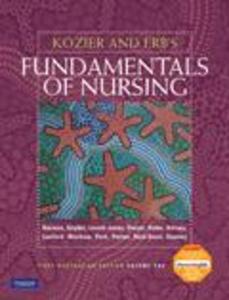Promoting family health
Brown, Sue (2010) Promoting family health. In: Berman, Audrey, Snyder, Shirlee J., Kozier, Barbara, Erb, Glenora, Levett-Jones, Tracy, Dwyer, Trudy, Hales, Majella, Harvey, Nichole, Luxford, Yoni, Moxham, Lorna, Park, Tanya, Parker, Barbara, Reid-Searl, Kerry, and Stanley, David, (eds.) Kozier and Erb's Fundamentals of Nursing. Pearson Australia, Frenchs Forest, NSW, Australia, pp. 448-461.
![[img]](https://researchonline.jcu.edu.au/16208/1.hassmallThumbnailVersion/16208_Brown_2010_Book_Cover.jpg)
|
Image (JPEG) (Book Cover)
- Cover Image
Download (5kB) |
|
|
PDF (Published Version)
- Published Version
Restricted to Repository staff only |
Abstract
For years Kozier & Erb’s Fundamentals of Nursing has been the gold standard in helping students embarking on their nursing careers. This first Australian edition retains many of the features that have made this textbook the number-one choice of nursing students and lecturers.
To further enhance this popular fundamentals textbook and ensure its appropriate application for Australian students, nursing academics from across Australia were invited to review and comment on each of the 52 chapters. Their detailed feedback has ensured that Kozier & Erb’s Fundamentals of Nursing: First Australian Edition is a current, engaging and uniquely Australian textbook that will help students succeed in their nursing studies.
Kozier and Erb’s Fundamentals of Nursing, First Australian Edition presents the fundamentals of nursing care within the framework of the nursing process. This text offers an accessible writing style; a focus on practical application with real-world Australian examples and case studies; appropriate Australian terminology, policies and procedures, Australian visuals; an integrated approach to Australian Indigenous health issues; and up-to-date references, research and codes of practice, with reference to ANMC guidelines. The text is supported by a state-of-the art technology package to enhance the learning process.
Chapter 24: Nurses assess and plan health care for three types of clients: the individual, the family and the community. The beliefs and values of each person and the support he or she receives come in large part from the family and are reinforced by the community. Thus, an understanding of family dynamics and the context of the community assists the nurse in planning care. When a family is the client, the nurse determines the health status of the family and its individual members, the level of family functioning, family interaction patterns and family strengths and weaknesses.
LEARNING OUTCOMES - Describe the roles and functions of the family. - Describe different types of families. - Identify theoretical frameworks used in family health promotion. - Identify the components of a family health assessment. - Identify common risk factors regarding family health. - Develop nursing diagnoses, outcomes and interventions pertaining to family functioning. - Develop outcome criteria for specific nursing diagnoses related to family functioning.
| Item ID: | 16208 |
|---|---|
| Item Type: | Book Chapter (Teaching Material) |
| ISBN: | 978-1-4425-0469-1 |
| Keywords: | extended family, family, family-centred nursing, feedback, input, negative feedback, nuclear family, output, positive feedback, subsystem, suprasystem, system, throughput |
| Date Deposited: | 21 Apr 2011 01:14 |
| FoR Codes: | 11 MEDICAL AND HEALTH SCIENCES > 1110 Nursing > 111099 Nursing not elsewhere classified @ 100% |
| SEO Codes: | 92 HEALTH > 9202 Health and Support Services > 920210 Nursing @ 100% |
| Downloads: |
Total: 60 Last 12 Months: 2 |
| More Statistics |



